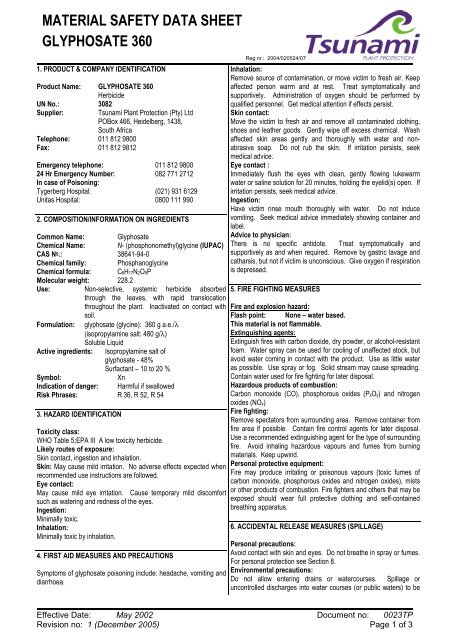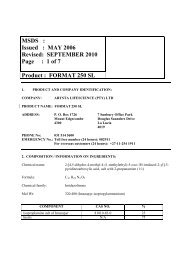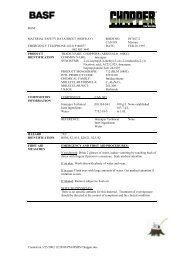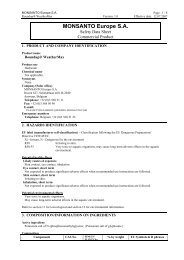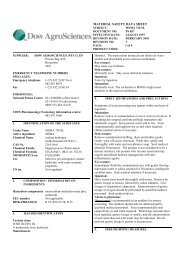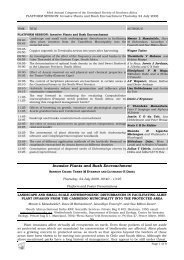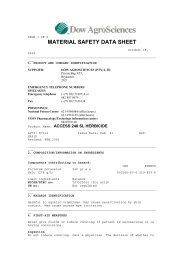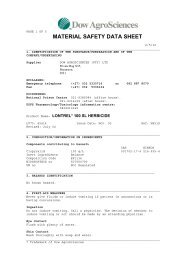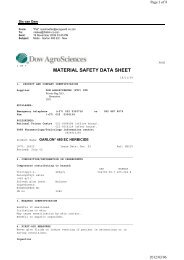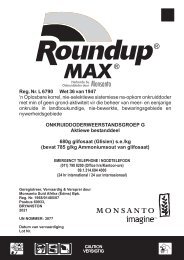MSDS Glyphosate 360 - Bush Encroachment
MSDS Glyphosate 360 - Bush Encroachment
MSDS Glyphosate 360 - Bush Encroachment
Create successful ePaper yourself
Turn your PDF publications into a flip-book with our unique Google optimized e-Paper software.
MATERIAL SAFETY DATA SHEET<br />
GLYPHOSATE <strong>360</strong><br />
1. PRODUCT & COMPANY IDENTIFICATION<br />
Product Name: GLYPHOSATE <strong>360</strong><br />
Herbicide<br />
UN No.: 3082<br />
Supplier:<br />
Telephone: 011 812 9800<br />
Fax: 011 812 9812<br />
Tsunami Plant Protection (Pty) Ltd<br />
POBox 466, Heidelberg, 1438,<br />
South Africa<br />
Emergency telephone: 011 812 9800<br />
24 Hr Emergency Number: 082 771 2712<br />
In case of Poisoning:<br />
Tygerberg Hospital: (021) 931 6129<br />
Unitas Hospital: 0800 111 990<br />
2. COMPOSITION/INFORMATION ON INGREDIENTS<br />
Common Name: <strong>Glyphosate</strong><br />
Chemical Name: N- (phosphonomethyl)glycine (IUPAC)<br />
CAS N o .: 38641-94-0<br />
Chemical family: Phosphanoglycine<br />
Chemical formula: C6H17N2O5P<br />
Molecular weight: 228.2<br />
Use: Non-selective, systemic herbicide absorbed<br />
through the leaves, with rapid translocation<br />
throughout the plant. Inactivated on contact with<br />
soil.<br />
Formulation:<br />
Active ingredients:<br />
glyphosate (glycine): <strong>360</strong> g a.e./λ<br />
(isopropylamine salt: 480 g/λ)<br />
Soluble Liquid<br />
Isopropylamine salt of<br />
glyphosate - 48%<br />
Surfactant – 10 to 20 %<br />
Symbol:<br />
Xn<br />
Indication of danger: Harmful if swallowed<br />
Risk Phrases: R 36, R 52, R 54<br />
3. HAZARD IDENTIFICATION<br />
Toxicity class:<br />
WHO Table 5;EPA III A low toxicity herbicide.<br />
Likely routes of exposure:<br />
Skin contact, ingestion and inhalation.<br />
Skin: May cause mild irritation. No adverse effects expected when<br />
recommended use instructions are followed.<br />
Eye contact:<br />
May cause mild eye irritation. Cause temporary mild discomfort<br />
such as watering and redness of the eyes.<br />
Ingestion:<br />
Minimally toxic.<br />
Inhalation:<br />
Minimally toxic by inhalation.<br />
4. FIRST AID MEASURES AND PRECAUTIONS<br />
Symptoms of glyphosate poisoning include: headache, vomiting and<br />
diarrhoea.<br />
Reg nr.: 2004/020524/07<br />
Inhalation:<br />
Remove source of contamination, or move victim to fresh air. Keep<br />
affected person warm and at rest. Treat symptomatically and<br />
supportively. Administration of oxygen should be performed by<br />
qualified personnel. Get medical attention if effects persist.<br />
Skin contact:<br />
Move the victim to fresh air and remove all contaminated clothing,<br />
shoes and leather goods. Gently wipe off excess chemical. Wash<br />
affected skin areas gently and thoroughly with water and nonabrasive<br />
soap. Do not rub the skin. If irritation persists, seek<br />
medical advice.<br />
Eye contact :<br />
Immediately flush the eyes with clean, gently flowing lukewarm<br />
water or saline solution for 20 minutes, holding the eyelid(s) open. If<br />
irritation persists, seek medical advice.<br />
Ingestion:<br />
Have victim rinse mouth thoroughly with water. Do not induce<br />
vomiting. Seek medical advice immediately showing container and<br />
label.<br />
Advice to physician:<br />
There is no specific antidote. Treat symptomatically and<br />
supportively as and when required. Remove by gastric lavage and<br />
catharsis, but not if victim is unconscious. Give oxygen if respiration<br />
is depressed.<br />
5. FIRE FIGHTING MEASURES<br />
Fire and explosion hazard:<br />
Flash point: None – water based.<br />
This material is not flammable.<br />
Extinguishing agents:<br />
Extinguish fires with carbon dioxide, dry powder, or alcohol-resistant<br />
foam. Water spray can be used for cooling of unaffected stock, but<br />
avoid water coming in contact with the product. Use as little water<br />
as possible. Use spray or fog. Solid stream may cause spreading.<br />
Contain water used for fire fighting for later disposal.<br />
Hazardous products of combustion:<br />
Carbon monoxide (CO), phosphorous oxides (PxOy) and nitrogen<br />
oxides (NOx)<br />
Fire fighting:<br />
Remove spectators from surrounding area. Remove container from<br />
fire area if possible. Contain fire control agents for later disposal.<br />
Use a recommended extinguishing agent for the type of surrounding<br />
fire. Avoid inhaling hazardous vapours and fumes from burning<br />
materials. Keep upwind.<br />
Personal protective equipment:<br />
Fire may produce irritating or poisonous vapours (toxic fumes of<br />
carbon monoxide, phosphorous oxides and nitrogen oxides), mists<br />
or other products of combustion. Fire fighters and others that may be<br />
exposed should wear full protective clothing and self-contained<br />
breathing apparatus.<br />
6. ACCIDENTAL RELEASE MEASURES (SPILLAGE)<br />
Personal precautions:<br />
Avoid contact with skin and eyes. Do not breathe in spray or fumes.<br />
For personal protection see Section 8.<br />
Environmental precautions:<br />
Do not allow entering drains or watercourses. Spillage or<br />
uncontrolled discharges into water courses (or public waters) to be<br />
Effective Date: May 2002 Document no: 0023TP<br />
Revision no: 1 (December 2005) Page 1 of 3
MATERIAL SAFETY DATA SHEET<br />
GLYPHOSATE <strong>360</strong><br />
reported immediately to the Police and to the Department of<br />
Water/Environmental Affairs.<br />
Occupational spill:<br />
Remove all sources of flames and sparks. For small liquid spills,<br />
soak up with lime, damp earth or sand, or other non-combustible<br />
absorbent material and place into containers for later disposal. For<br />
large liquid spills, contain the liquid for later disposal. In situations<br />
where product comes in contact with water, contain contaminated<br />
water for later disposal. Do not flush spilled material into drains.<br />
Keep spectators away.<br />
7. HANDLING AND STORAGE REQUIREMENTS<br />
Handling:<br />
Avoid contact with eyes, prolonged contact with skin, and inhalation<br />
of spray and fumes. Handle product with caution. Use with<br />
adequate ventilation. Wash hands before eating, drinking, chewing<br />
gum, smoking or using the toilet. Remove clothing immediately if<br />
the herbicide gets inside. Then wash skin thoroughly using a nonabrasive<br />
soap and put on clean clothing. Operators should change<br />
and wash clothing after use. Do not apply directly to areas where<br />
surface water is present, or to intertidal areas below the mean high<br />
water mark. Water used to clean equipment must be disposed of<br />
correctly to avoid contamination.<br />
Storage:<br />
Store in its original, labelled and closed container in dry, cool,<br />
shaded, well-ventilated area, away from heat, sparks and other<br />
sources of ignition. Do not store with other pesticides, fertilizer,<br />
seeds, foodstuffs and water supplies. Store away from incompatible<br />
substances. Product is incompatible with galvanized steel or unlined<br />
mild steel. Keep out of reach of unauthorized persons, children and<br />
animals. Local regulations should be complied with.<br />
8. EXPOSURE CONTROL / PERSONAL PROTECTION<br />
It is essential to provide adequate ventilation. The measures<br />
appropriate for a particular work site depend on how this material is<br />
used and on the extent of exposure. Ensure that control systems<br />
are properly designed and maintained. Comply with occupational<br />
safety, environmental, fire and other applicable regulations.<br />
PERSONAL PROTECTIVE EQUIPMENT:<br />
If engineering controls and work practices are not effective in<br />
controlling exposure to this material, then wear suitable personal<br />
protective equipment including approved respiratory protection.<br />
Respirator:<br />
It is usually safe to use the product without a mask or respirator. If<br />
the product is used in dusty or confined conditions, a mask or<br />
respirator suitable for protection from dusts and mists of pesticides is<br />
adequate. Limitations of respirator use specified by the approving<br />
agency and the manufacturer must be observed.<br />
Clothing:<br />
Employee must wear appropriate protective (impervious) clothing<br />
and equipment to prevent repeated or prolonged skin contact with<br />
this substance.<br />
Gloves:<br />
Employee must wear appropriate synthetic protective gloves to<br />
prevent contact with this substance.<br />
Eye protection:<br />
Wear safety goggles or face shield.<br />
Emergency eye wash: Where there is any possibility that an<br />
employee’s eyes may be exposed to this substance, the employer<br />
Reg nr.: 2004/020524/07<br />
should provide an eye wash fountain or appropriate alternative<br />
within the immediate work area for emergency use.<br />
9. PHYSICAL AND CHEMICAL PROPERTIES<br />
Appearance: Clear golden yellow to amber liquid.<br />
Odour:<br />
Mild halide odour.<br />
Relative density: 1.165 ± 0.05 g/cm 3<br />
Solubility in water: Completely miscible.<br />
Flash point:<br />
None. Water based. Does not flash.<br />
pH: 4,94<br />
Oxidising properties: None.<br />
Corrosiveness: Corrosive to galvanized steel and mild<br />
steel.<br />
10. STABILITY AND REACTIVITY<br />
Stability:<br />
Stable under normal temperatures and pressures. <strong>Glyphosate</strong><br />
reacts strongly (possibly violent exothermic reaction) with strong<br />
alkalis. Photodecomposition is negligible. Is stable to light and also<br />
stable up to 60 o C. Product is unlikely to spontaneously polymerise<br />
or decompose. Decompose only after heating to dryness followed<br />
by further heating.<br />
<strong>Glyphosate</strong> may be photolabile in natural waters, with calcium or<br />
other metal ions acting as catalysts for the process.<br />
Dilution stability:<br />
Stable in aqueous solutions at 20 o C.<br />
Storage stability:<br />
Stable for 2 years under normal warehouse conditions. Store at<br />
temperatures below 50 O C and above –15 O C. Stable to light.<br />
Partial crystallization may occur on prolonged storage below –15 O C.<br />
Incompatibility:<br />
Product is relatively stable in neutral, weakly acidic and weakly<br />
alkaline media, but reacts strongly (and possibly violently) with<br />
strong alkalis. Mixing with other products may reduce the activity of<br />
glyphosate. Incompatible with galvanized steel and unlined mild<br />
steel materials for storage.<br />
Thermal decomposition:<br />
Toxic oxides of carbon, nitrogen and phosphorus are released when<br />
the product decomposes on heating.<br />
11. TOXICOLOGICAL INFORMATION<br />
Acute oral LD50:<br />
5400 mg/kg in rats.<br />
Acute dermal LD50:<br />
> 5 000 mg/kg in rats.<br />
Inhalation:<br />
Technical: LC50 (4 hours): > 1,3 mg/λ.<br />
Acute skin irritation:<br />
Not irritating to skin (rabbit). Not skin sensitizer.<br />
Acute eye irritation:<br />
Slightly irritating to eyes (rabbit).<br />
Carcinogenicity:<br />
Animal studies did not detect any carcinogenic effects.<br />
Teratogenicity:<br />
Animal studies did not detect any teratogenic effects.<br />
Mutagenicity:<br />
Animal studies did not detect any mutagenic effects.<br />
Effective Date: May 2002 Document no: 0023TP<br />
Revision no: 1 (December 2005) Page 2 of 3
MATERIAL SAFETY DATA SHEET<br />
GLYPHOSATE <strong>360</strong><br />
Reproductivity:<br />
Reproductive changes in test animals only occur at very high doses.<br />
It is unlikely that glyphosate would produce effects in humans.<br />
12. ECOLOGICAL INFORMATION<br />
Degradability:<br />
<strong>Glyphosate</strong> is moderately persistent in soil, with estimated half-life of<br />
47 days. Microbes are primarily responsible for breakdown.<br />
<strong>Glyphosate</strong> is strongly adsorbed to suspended organic and mineral<br />
matter in water, and broken down primarily by microbes. Half-life<br />
ranges from 12 days to 10 weeks.<br />
Mobility:<br />
The product is practically immobile. It is strongly absorbed to most<br />
soils. It does not leach appreciably, and has low potential for runoff.<br />
Accumulation:<br />
The product shows little or no tendency to bioaccumulate and poses<br />
no long term threat to wildlife.<br />
ECOTOXICOLOGY:<br />
Birds: Slightly toxic.<br />
LC50 (5-day diet): Mallard duck: > 4500 mg/kg diet<br />
Reg nr.: 2004/020524/07<br />
Do not re-use the empty container for any other purpose but destroy<br />
it by perforation and flattening and bury in an approved dump site.<br />
Prevent contamination of food, feedstuffs, drinking water and eating<br />
utensils.<br />
Comply with local legislation applying to waste disposal.<br />
14. TRANSPORT INFORMATION<br />
UN NUMBER: 3082<br />
Road Transport ADR/IRD:<br />
Class: 9<br />
Packing group:<br />
Shipping name:<br />
Maritime Transport IMDG/IMO:<br />
Class: 9<br />
Packing group: III<br />
Shipping name:<br />
Considered a Marine Pollutant.<br />
III<br />
Environmentally hazardous substance,<br />
liquid, N.O.S. (herbicide - glyphosate)<br />
Environmentally hazardous substance,<br />
liquid, N.O.S. (herbicide - glyphosate)<br />
Bobwhite quail: > 4500 mg/kg diet<br />
Fish: Not toxic.<br />
15. REGULATORY INFORMATION<br />
LC50 (96 hours): Bluegill sunfish: > 1000 mg/λ Symbol:<br />
N<br />
Trout:<br />
> 1000 mg/λ Indication: Environmentally dangerous substance.<br />
Fathead minnows 97 mg/λ Risk phrases:<br />
Due to surfactant, GLYPHOSATE <strong>360</strong> is moderately toxic to R 36 Irritating to eyes.<br />
fish.<br />
Bees: Not toxic.<br />
R 52<br />
R 54<br />
Harmful to aquatic organisms.<br />
Toxic to flora.<br />
LD50 oral & dermal:<br />
> 0.1 mg/bee Safety phrases:<br />
Daphnia:<br />
LC50 (48 hours):<br />
930 mg/λ<br />
S 2<br />
S 2425<br />
Keep out of reach children.<br />
Avoid contact with skin and eyes.<br />
Earthworms:<br />
S 36/37/39 Wear suitable protective clothing, gloves and<br />
LC50 (14 days): Eisenia foetida: > 5000 mg/kg soil<br />
eye/face protection.<br />
Other Beneficial organisms:<br />
No effect on carabid beetles. Harmless to slightly harmful to green<br />
lacewing, parasite species, mites / spiders and insects. Moderately<br />
harmful to Bembidion lampros.<br />
S 45<br />
S 61<br />
In case of accident or if you feel unwell, seek<br />
medical advice immediately (show the label where<br />
possible).<br />
Avoid release to the environment.<br />
13. DISPOSAL CONSIDERATION<br />
16. OTHER INFORMATION<br />
Pesticide disposal:<br />
Open dumping or burning of this pesticide is prohibited Waste<br />
resulting from the use of this product that cannot be reused or<br />
reprocessed. Never pour untreated waste or surplus products into<br />
public sewers or where there is any danger of run-off or seepage<br />
into water systems. Do not contaminate rivers, dams or any other<br />
water sources with the product or used containers.<br />
Comply with local legislation applying to waste disposal.<br />
Container disposal:<br />
Emptied containers retain vapour and product residues. Observe all<br />
labelled safeguards until container is destroyed.<br />
TRIPLE RINSE empty containers in the following manner: Invert the<br />
empty container over the spray or mixing tank and allow to drain for<br />
at least 30 seconds after the flow has slowed down to a drip.<br />
Thereafter rinse the container three times with a volume of water<br />
equal to a minimum of 10 % of that of the container. Add the<br />
rinsings to the contents of the spray tank before destroying the<br />
container in the prescribed manner.<br />
Packaging and Labelling:<br />
Packed in 200 mλ, 500mλ & 1, 2, 5, 10, 20 and 25 λ fluorinated<br />
plastic containers and labelled according to South African<br />
regulations and guidelines.<br />
Disclaimer:<br />
The information on this sheet is not a specification; it does not<br />
guarantee specific properties. The information is intended to provide<br />
general guidance as to health and safety based upon our knowledge<br />
of the handling, storage use of the product. It is not applicable to<br />
unusual or non-standard uses of the product nor where instructions<br />
or recommendations are not followed.<br />
All information is given in good faith but without guarantee in respect<br />
of accuracy, and no responsibility is accepted for errors and<br />
omissions or the consequence thereof.<br />
END OF DOCUMENT<br />
Compiled: May 2002 Reviewed: December 2005<br />
Effective Date: May 2002 Document no: 0023TP<br />
Revision no: 1 (December 2005) Page 3 of 3


